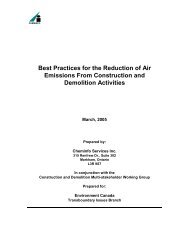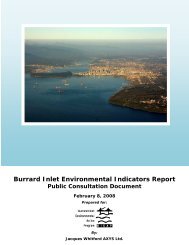Biodiversity Conservation - the BIEAP and FREMP Website
Biodiversity Conservation - the BIEAP and FREMP Website
Biodiversity Conservation - the BIEAP and FREMP Website
Create successful ePaper yourself
Turn your PDF publications into a flip-book with our unique Google optimized e-Paper software.
Exploring Next Steps for Action<br />
Documents from <strong>the</strong> <strong>Biodiversity</strong> <strong>Conservation</strong> Strategy Partnership continued<br />
Phase One: Review of Key <strong>Biodiversity</strong> <strong>Conservation</strong><br />
Issues, Roles <strong>and</strong> Responsibilities This 124-page<br />
document reports <strong>the</strong> results of interviews which<br />
identify biodiversity initiatives undertaken by different<br />
governments <strong>and</strong> o<strong>the</strong>r stakeholders in <strong>the</strong> Greater<br />
Vancouver Region. It describes <strong>the</strong> priorities, issues<br />
<strong>and</strong> challenges of those different groups <strong>and</strong> <strong>the</strong><br />
biodiversity data <strong>the</strong>y possess. It reviews legislation <strong>and</strong><br />
regulations, <strong>and</strong> policy <strong>and</strong> planning tools of different<br />
levels of government, <strong>and</strong> includes multiple tables<br />
showing interrelationships of organizations, legislation<br />
<strong>and</strong> planning tools with particular biodiversity actions<br />
or ecosystem components. It describes gaps in <strong>the</strong><br />
administrative framework for biodiversity conservation<br />
<strong>and</strong> recommends some future steps for administrative<br />
organization <strong>and</strong> adaptive management.<br />
Phase Two: Socio-Economic Values of <strong>Biodiversity</strong> in<br />
<strong>the</strong> Greater Vancouver Region This 47-page report<br />
describes several local cases (integrated stormwater<br />
management, forest conservation areas <strong>and</strong> municipal<br />
tree protection) <strong>and</strong> conservation initiatives (riparian<br />
greenways, <strong>the</strong> Greenfields Program <strong>and</strong> Maplewood<br />
Flats <strong>Conservation</strong> Area). It shows financial <strong>and</strong><br />
qualitative estimates of <strong>the</strong> socio-economic benefits<br />
provided by biodiversity <strong>and</strong> how biodiversity information<br />
is used in decision-making.<br />
Phase Three: Priorities, Opportunities <strong>and</strong> Strategic<br />
Directions This is an 82-page report which briefly<br />
summarizes <strong>the</strong> phase one <strong>and</strong> phase two reports <strong>and</strong><br />
identifies 24 potential regional biodiversity priorities.<br />
The document ranks <strong>the</strong> 24 potential activities into four<br />
categories of decreasing priority, based upon how well<br />
biodiversity is addressed by each <strong>and</strong> how relatively easy<br />
<strong>the</strong>y are to implement. It provides tables interrelating<br />
existing biodiversity initiatives <strong>and</strong> biodiversity priorities.<br />
The report also discusses which organizations might be<br />
able to address different priorities <strong>and</strong> where particular<br />
gaps are. It provides 20 specific recommendations.<br />
A Review of Regional <strong>Biodiversity</strong> <strong>Conservation</strong> Strategies<br />
This 24-page report describes basic information about<br />
nine regional biodiversity conservation strategies from<br />
Australia, Canada, Engl<strong>and</strong> <strong>and</strong> <strong>the</strong> United States. Six of<br />
<strong>the</strong> strategies are from major urban regions <strong>and</strong> three<br />
are mixed-use l<strong>and</strong>scape plans. It also lists example<br />
initiatives that have resulted from <strong>the</strong> strategies.<br />
Great rivers are born in small streams <strong>and</strong> wetl<strong>and</strong>s.<br />
The health <strong>and</strong> productivity of rivers depend upon how<br />
intact this system is. Small streams <strong>and</strong> wetl<strong>and</strong>s provide<br />
invaluable ecosystem services such as natural flood control,<br />
groundwater recharge, <strong>and</strong> nutrients recycle. They also<br />
provide shelter, food, spawning sites <strong>and</strong> nursery areas,<br />
<strong>and</strong> travel corridors through <strong>the</strong> l<strong>and</strong>scape. Many species<br />
depend on small streams <strong>and</strong> wetl<strong>and</strong>s at some point in<br />
<strong>the</strong>ir life history including salmon.<br />
Strategic Directions for <strong>Biodiversity</strong> <strong>Conservation</strong> in <strong>the</strong> Metro Vancouver Region | Forum Proceedings: Key Points <strong>and</strong> Potential Action Steps<br />
Also available from <strong>the</strong> Metro Vancouver webpage.<br />
28<br />
There are multiple links to valuable biodiversity <strong>and</strong><br />
environmental planning information from <strong>the</strong> Metro<br />
Vancouver webpage listed above. However, specifically<br />
relevant to <strong>the</strong> Strategic Directions report <strong>and</strong> <strong>the</strong><br />
Forum are those under <strong>the</strong> top link in <strong>the</strong> menu on <strong>the</strong><br />
right: “<strong>Biodiversity</strong> BC”. From <strong>the</strong> “Downloads” menu on<br />
<strong>the</strong> left side of <strong>the</strong> <strong>Biodiversity</strong> BC homepage one can<br />
obtain <strong>the</strong>ir major report Taking Nature’s Pulse, which<br />
was mentioned by several speakers at <strong>the</strong> Forum. In <strong>the</strong><br />
same list, <strong>the</strong> report Ecological Principles, Concepts <strong>and</strong><br />
Applications to <strong>Conservation</strong> provides a sound summary<br />
of basic ideas of ecology <strong>and</strong> conservation biology<br />
<strong>and</strong> how <strong>the</strong>y provide <strong>the</strong> foundation for <strong>the</strong> kinds of<br />
actions discussed throughout <strong>the</strong> Strategic Directions<br />
document. The entire BC <strong>Biodiversity</strong> Atlas is also<br />
available from <strong>the</strong> same page.
















